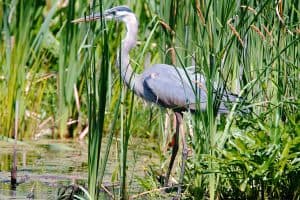
Happy Fall, wildlife lovers, here we have arrived at the end of summer, and I haven’t checked in for quite a while. Westford Wildlife Watch was first published in 1990, and has appeared monthly since then—34 years! This article will occur only occasionally in the future, as I plan to spend the next year collecting and editing the articles into what I hope will become the book, Westford Wildlife Watch: thirty-five years of Learning and Joy.
This summer it has become even more obvious that our climate is changing. July was the hottest month ever recorded. And our weather has also become wetter. This year to date in Massachusetts we have had six inches of rain (34.14” compared to our normal of 28.07”). This increasingly warm and wet climate is allowing insects to survive later into the year—more ticks and mosquitoes bring new diseases but also more food for birds. Some plants and animals are expanding their ranges northward. These changes are happening at a rapid pace, and we can’t predict how it will change the flora and fauna. Some forecasters say that our climate soon will resemble Baltimore’s. I grew up in Washington, D.C., and remember just how hot those summers were. My parents sent us kids up to New Hampshire to enjoy the cool summers with our grandparents.
Invasive plants have moved north: Phragmites in our wetlands, Japanese Knotweed, and Mile-a-Minute to name a few. Some birds are changing their migration patterns, and many have moved up from the south and become year-round residents in my lifetime: Tufted Titmouse, Northern Cardinal, Northern Mockingbird, Northern Flicker, Red-bellied Woodpecker, and Carolina Wren, among others. These birds can now survive our warmer winters. There will be many interesting changes to come.
For this fall, we will all be sadly watching the southerly migration of “our” summer birds such as Baltimore Orioles, Ruby-throated Hummingbirds, Phoebes, Gray Catbirds, Red-winged Blackbirds and Grackles (we may not miss the grackles as much). And some birds will move from upper New England and Canada to spend the winter with us such as winter Robins and Dark-eyed Juncos (“snowbirds”), and if we’re lucky, Pine Siskins, Pine Grosbeaks, and Snowy Owls. So, there is something to look forward to.
Many thanks to all flora and fauna reporters for this summer. I hope you will continue to send me sightings of interest. I will publish them on the Westford Conservation Trust’s website from time to time. Send reports to me at mariancharman@gmail.com.
Summer Reports
May Report
Gerry DiBello, Court Rd. May 1, an oriole at the feeder. It likes blueberry jelly.
Marian/Bill Harman, Old Colony Drive. May 6, 78 degrees, warm and humid. Pileated woodpecker calling loudly and hammering on a living pine, finding grubs, very near the deck. Another flew in with a higher call—mate? May 7, off Rt. 110, a yellow-rumped warbler hovering and hawking insects from the air like a phoebe. Yellow warbler heard in the wetlands. May 8, on Old Lowell Rd., two catbirds singing up a storm—first I’ve heard this year. May 9, female hummingbird at our feeder—first this year. May 11 Annual Bird Walk led by Lennie Palmer for the Westford Conservation Trust. At Nashoba Pond, Plants blooming: starflower, buttercup, violet, highbush blueberry, marsh marigold, Canada mayflower. Birds (36 species!): Chickadee, titmouse, white-breasted nuthatch, red-winged blackbirds, grackles, brown-headed cowbird, eastern bluebird, great-crested flycatcher, yellow-rumped warbler, common yellowthroat, redstart, turkey vulture overhead, then landed and posed for us, wings outspread), downy woodpecker, pileated woodpecker, Carolina wren, warbling vireo, Baltimore oriole (2), phoebe nesting, rose-breasted grosbeak, swallows (tree, rough-winged, barn), song sparrow, chipping sparrow, robin, northern waterthrush, red-eyed vireo, eastern kingbird, blue jay, northern cardinal, gray catbird, blue-headed vireo, veery, ovenbirds, blue-gray gnatcatcher, scarlet tanager, Canada geese. May 13, at feeder: Rose-breasted grosbeak male, gobbling seeds and singing beautifully between bites. May 20, sunny, 60’s. Blackpoll warbler singing here, first oriole heard, sounded like “I have a sim-ple song now” Two butterflies here: tiger swallowtail, and red admiral. Nineteen ladies’ slippers blooming, twenty-eight ladies’ slippers not blooming.
Tom Ennis, May 13, at Acker Land. Shadbush is blooming [Tom sent a lovely photo. MH]
June Report
Marian/Bill Harman, Old Colony Drive. June 1, 70’s, breezy. Great clouds of yellow pollen are wafting across the yard with every gust of wind.
Haiku:
Great clouds of pollen
Wafting yellow across the yard.
New pines will be born.
—————-
Bill has foiled a squirrel who figured out our double baffle system. He adjusted the spacing of the baffles, and now they can’t seem to access the feeder. June 3, deer flies already—a month early (groan). June 6, 70’s, rainy. A female rose-breasted grosbeak on the feeder. June 7, 80’s, sunny. Great blue heron under the feeder, hunting chipmunks as it did last year. June 9, 60’s, rainy, bluebird flew in front of me and landed on a street sign on Pilgrim Drive. June 16, 70’s lovely Father’s Day.
Haiku:
Father’s Day at Camp,
Three generations gather.
Laughter, Love and Joy
—————
June 17, 76-80’s. This will be the start of a multi-day heat wave predicted.
At the feeder: Red-bellied woodpecker, mourning doves, blue jays, lots of grackles, red-winged blackbirds, cardinal pair, four blue jays.
June 18, hot and sunny, 90’s. On trail at Emmet Land, Texas Rd, a Blanding’s Turtle! (seen and photographed by Regina D’Antuono)
June 20, high 90’s for past two days! June 21, barred owl calling at night. June 23, 80’s, very humid, tornado watch! Baby day at the feeder: Baby grackles, titmice, cardinals, bluebirds, all begging for food. Also heard a scarlet tanager singing loudly in the side yard. Saw goldfinches, blue jays, red-bellied woodpecker, heard blue-gray gnatcatcher, phoebe. A walk on Old Colony Drive, heard a house wren (beautiful, bubbly song), pee-wee. Saw three chipping sparrows.
Tom Ennis, Almeria Drive. June 12, a catbird in yard. Bluebirds are raising a family in a beautiful new “high-rise” bluebird box that Tom built.
Marilyn Day, Coldspring Rd. June 18, Catalpa trees in bloom. “These were first introduced in the north by Gilchrist’s Dept. Store. Several hundred were sent to the students of Westford and other towns in 1911. Now they can be seen on Main St, Chamberlain Rd, and Graniteville Rd., among other places in town.”
July Reports:
Marian/Bill Harman, Old Colony Drive. July 1 at Sawmill Drive, a veery singing. July 3, wood thrush singing, two species of lightning bugs in the wildflowers along our side yard. July 4, 80’s, humid. A walk on Old Colony and Pilgrim Drives: lots of robins flying around, adults and juveniles, nuthatch, pileated woodpecker calling, female hummingbird, not shy, coming to feeder on our deck railing. July 6, 80’s, very humid, young blue jay who is the same size as its parent, is following parent around and begging. A walk on Old Colony and Pilgrim, chipping sparrow, robins, pileated woodpecker, several patches of Indian pipes are up—beautiful! July 23, seven fish crows at our feeder, mamma turkey and some older babies. July was the hottest month on record!
Marilyn Day, Graniteville Rd. July 18, cedar waxwings nesting here this week, in the large spruce trees. They love the honeysuckle berry bushes.
August Reports:
Marian/Bill Harman, Old Colony Drive. August 4, cloudy, rain. Four hummingbirds at feeder, one male, one female and two juveniles (a family?) A hairy woodpecker also enjoys the sugar water feeder. August 5, to 90’s, sunny. A great blue heron is making a racket at the pond. The lovely small of blooming sweet pepper bush is in the air. Four teen-aged turkeys, led by mom came out of the woods to the feeder. A young flicker on the lawn, eating ants. August 7, 67 degrees and low humidity at last! At the feeder, nine blue jays, mostly juveniles probably. A hairy woodpecker one titmouse, adult male red-bellied woodpecker, two downy woodpeckers, a pair of cardinals, many grackles, both adult and juvenile, three goldfinches, two hummingbirds, one male and one female, a mourning dove. A walk on the beaver dam trail: a gorgeous day—the first I have wanted to take a walk on the trail since late April, due to high humidity and biting insects. How nice to renew my acquaintance with the plants here. A few new plants to me in the wet areas: stalked bulrush, spider bulrush, monkey flower. Some animal opened the pods of the beaked hazel and ate the seeds. Heard: blue jay mimicking a juvenile red-tailed hawk call, several catbirds in the shrubs along Snake Meadow Brook, meowing at me. A great blue heron took off from the brook with its harsh cries. It had seen me from a long way off. Green frogs twanging in the brook. August 25, 80’s, sunny. Juvenile hummingbird at the feeder, great blue heron heard, four crows at the feeder, a tufted titmouse, several goldfinches, a juvenile chickadee. August 26, three hummingbirds. August 29, 70’s, sunny. A walk to the beaver dam: Lots of Indian pipes! Some in patches as large as 6-8 ft. in diameter. Saw a new plant to me: 3-leaved snakeroot. Heard: great blue heron, mourning doves, catbird, chickadee, downy woodpecker, titmouse, nuthatch. August 31, 70’s, sunny. Female hummingbird at feeder, turkey family in back yard. The 6 babies are almost as big as mother now
Marian Harman is a member of the Westford Conservation Trust, Inc., a non-profit conservation organization whose purpose is the protection of Westford’s open spaces and trails. The Trust welcomes new members and volunteers. Check out the Trust’s website at westfordconservationtrust.org, or visit us on Facebook.

